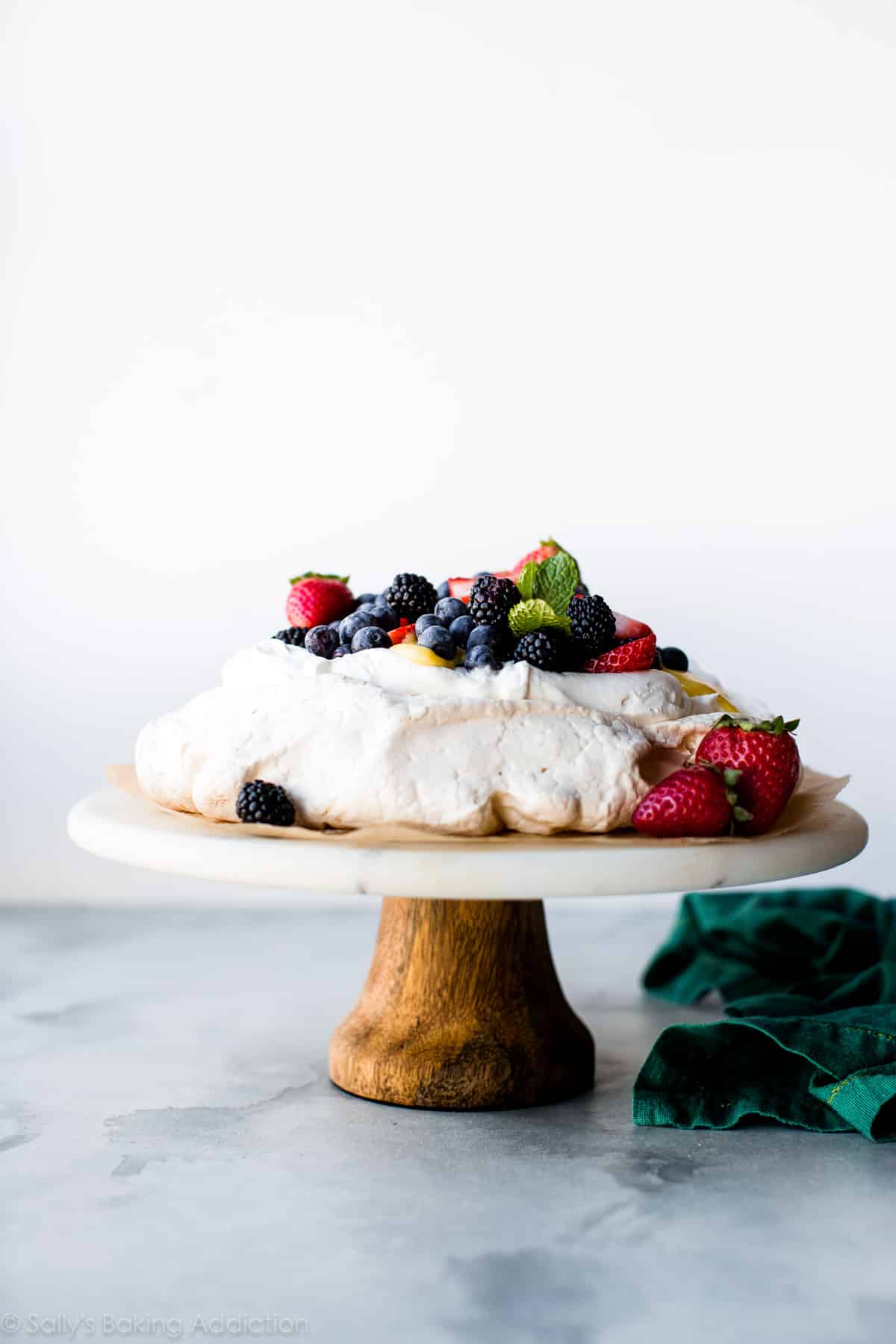
Another fresh and exciting recipe for you!
What is pavlova? Pavlova is a dessert popular in New Zealand and Australia. It’s not as common here in the states, but I hope to help change that! A texture lover’s dream come true, pavlova is made from egg whites that are slowly baked in a relatively cool oven. The egg whites take on a chewy-crisp texture on top, a soft marshmallow texture inside, and a crunchy crisp texture around the edges. That’s three completely different textures in one single bite. The crunchy edges are just like meringue cookies.
Pavlova loves to be dressed up with assorted toppings, mainly fresh whipped cream and piles of fresh fruit. Naturally gluten free, pavlova is light, sweet, and screams warm weather favorite. Happy spring, my friends, we’re making PAVLOVA!!
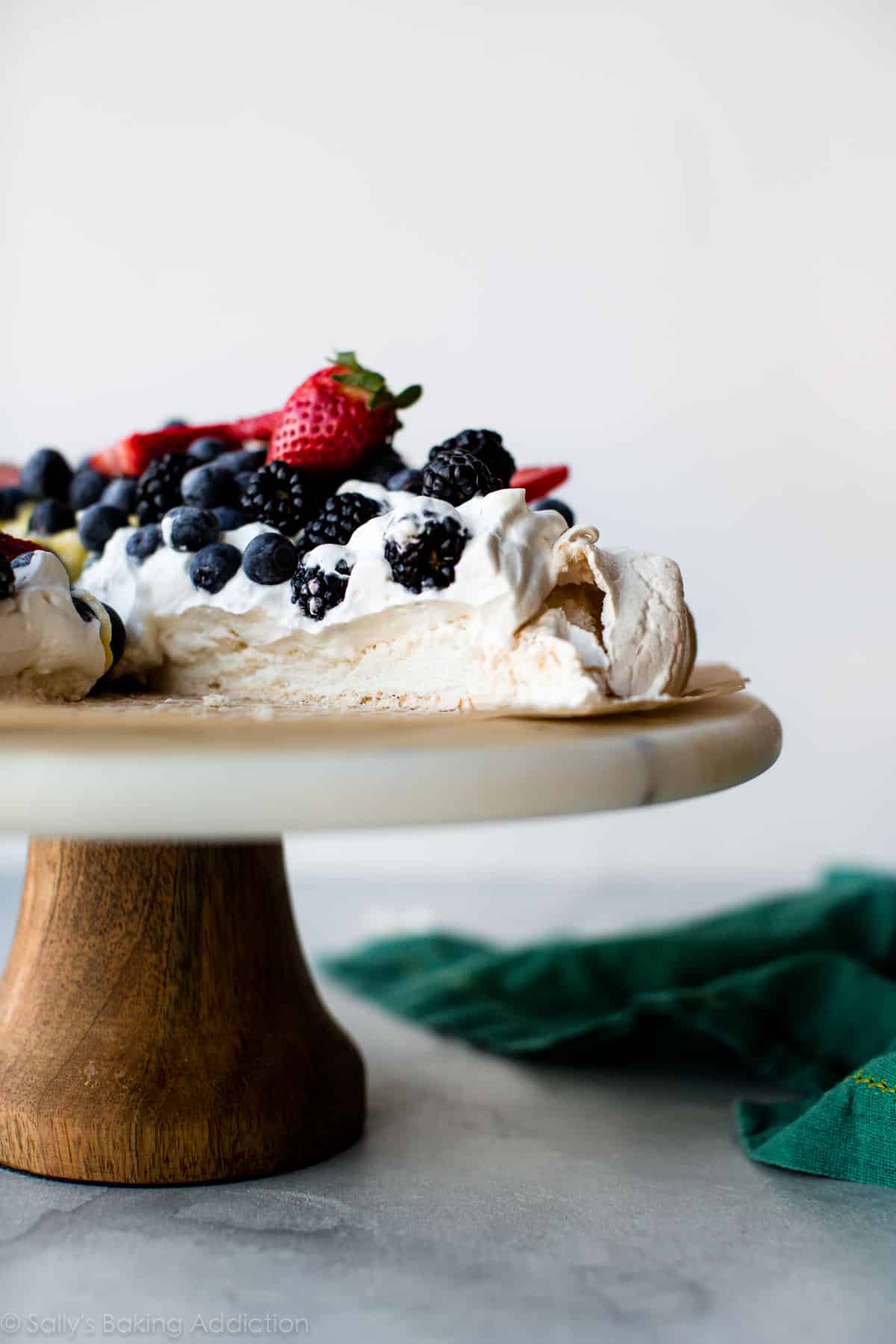
Video Tutorial: How to Make Pavlova
To obtain the unique pavlova texture, you must adhere to an exact recipe. While it’s fun to play around with ingredients, pavlova is not the time to stray from what’s listed. It’s picky, but picky doesn’t mean difficult. In fact, you only need 5 ingredients to make pavlova and I bet you have each in your kitchen right now:
- Egg whites
- Sugar
- An acid such as cream of tartar or vinegar
- Cornstarch
- Vanilla extract
Let me explain why these ingredients are used.
Pavlova Ingredients
- Egg whites – beaten into stiff peaks, egg whites are the base and volume of pavlova.
- Sugar – in addition to sweetening the dessert, sugar stabilizes the egg whites by holding them together both in the oven and as the whole pavlova cools. Without sugar, the protein molecules (science!) in egg whites will collapse. Additionally, sugar helps achieve the delightfully crisp texture. (Sugar is so much more than a sweetener in our baked goods.) Speaking of sugar, make sure that you use superfine or castor sugar. Just pulse sugar a few times in a food processor to reduce the size of the crystals.
- Acid – you can use 1/2 teaspoon of cream of tartar or 1 teaspoon white, apple cider vinegar, or even lemon juice. The pavlova will NOT taste like vinegar, I promise. The acid helps the egg whites hold onto air and, like the sugar, helps prevent the egg whites from collapsing. I tested with both and I actually prefer cream of tartar. I found that my pavlova spread a bit more when I used liquid acid.
- Cornstarch – I tested pav with and without cornstarch. I found that the center was fluffier and more marshmallow-y with cornstarch. Then I tested with 1 teaspoon cornstarch and 2 teaspoons cornstarch. I found it was a little chalky tasting with 2 teaspoons. I’m sticking to 1 teaspoon.
- Vanilla extract – purely for flavor!
(Not sponsored by any of these companies, but here’s exactly what I use.)
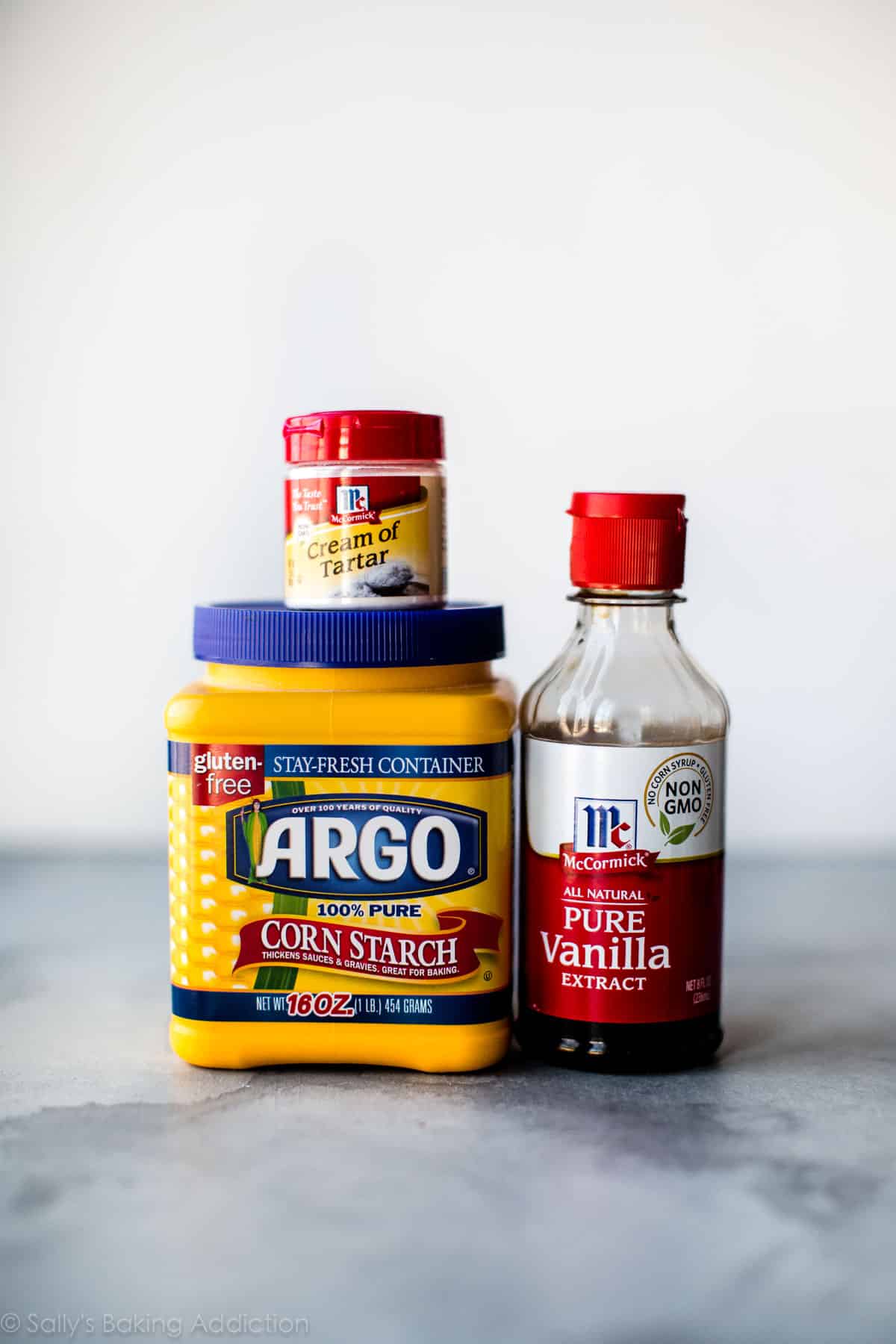
Ingredients are simple and method is effortless. There’s plenty of downtime when making pavlova. All you really have to do is watch it beat in your stand mixer then check on it in your oven. Kick your feet up!
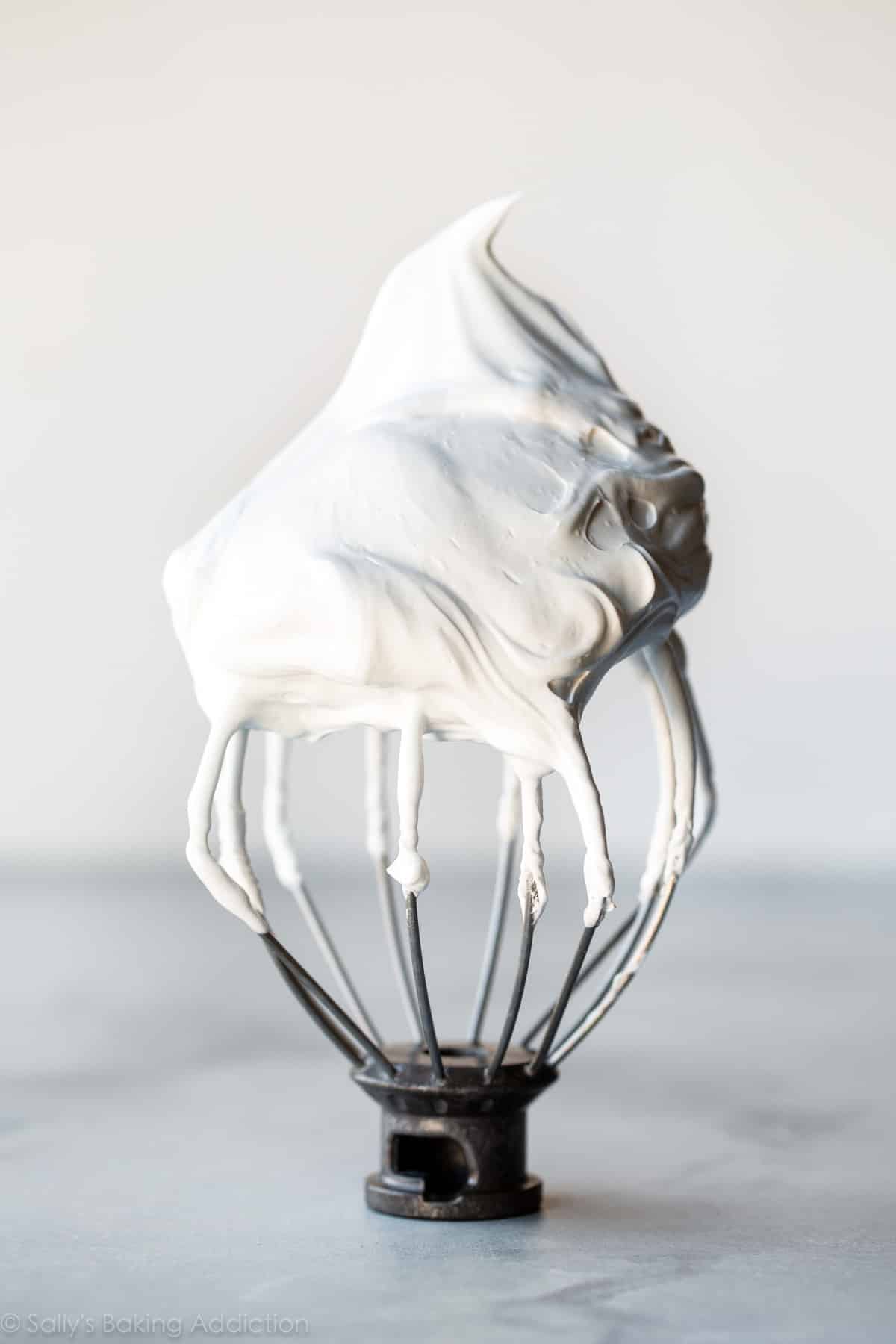
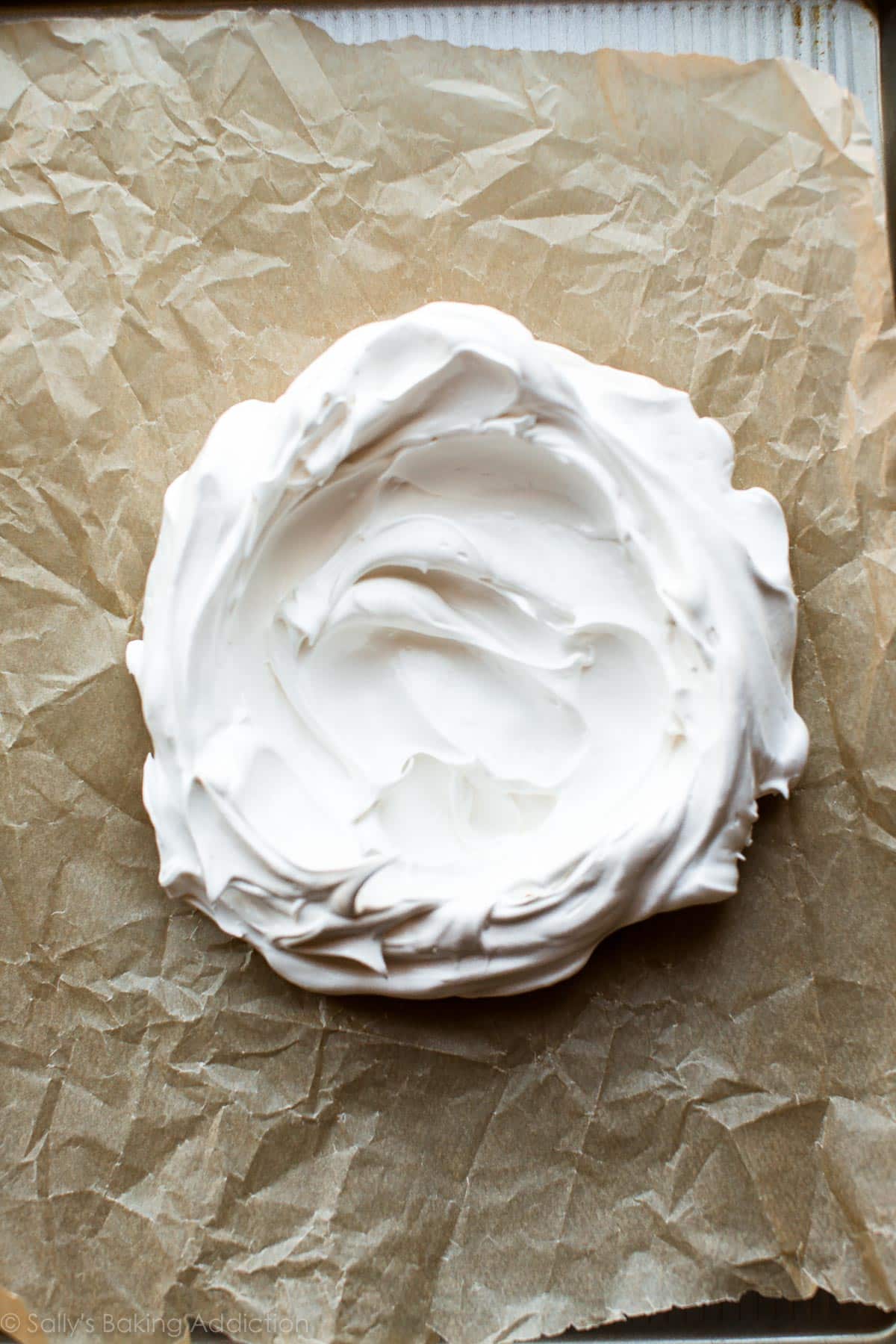
Just like our chocolate swirled meringue cookies and the meringue on our lemon meringue pie, whip the egg whites into super stiff peaks. Stiff enough that you can hold the whisk over your head and feel confident that the whipped egg whites won’t drop. 😉 Then you’ll spread the pavlova mixture onto your lined baking pan. You can use parchment paper or a silicone baking mat. Do not grease the baking pan—use a nonstick surface instead. Spread it into a circle, about 8-9 inches in diameter. You can eyeball it or trace one with a pencil. I just eyeball it. Like I did in the lemon meringue pie video, use the back of a spoon to create decorative peaks. Make sure the edges are tall and you have a nice dip in the center. That’s were we’ll pile our whipped cream and fruit!
Alternatively, you can make mini pavlovas. Here I piped the mixture into 6 mini pavlovas using Ateco 849. A piping tip isn’t necessary—you can just spoon it on. Again, make sure you leave a dip in the center to hold the toppings.
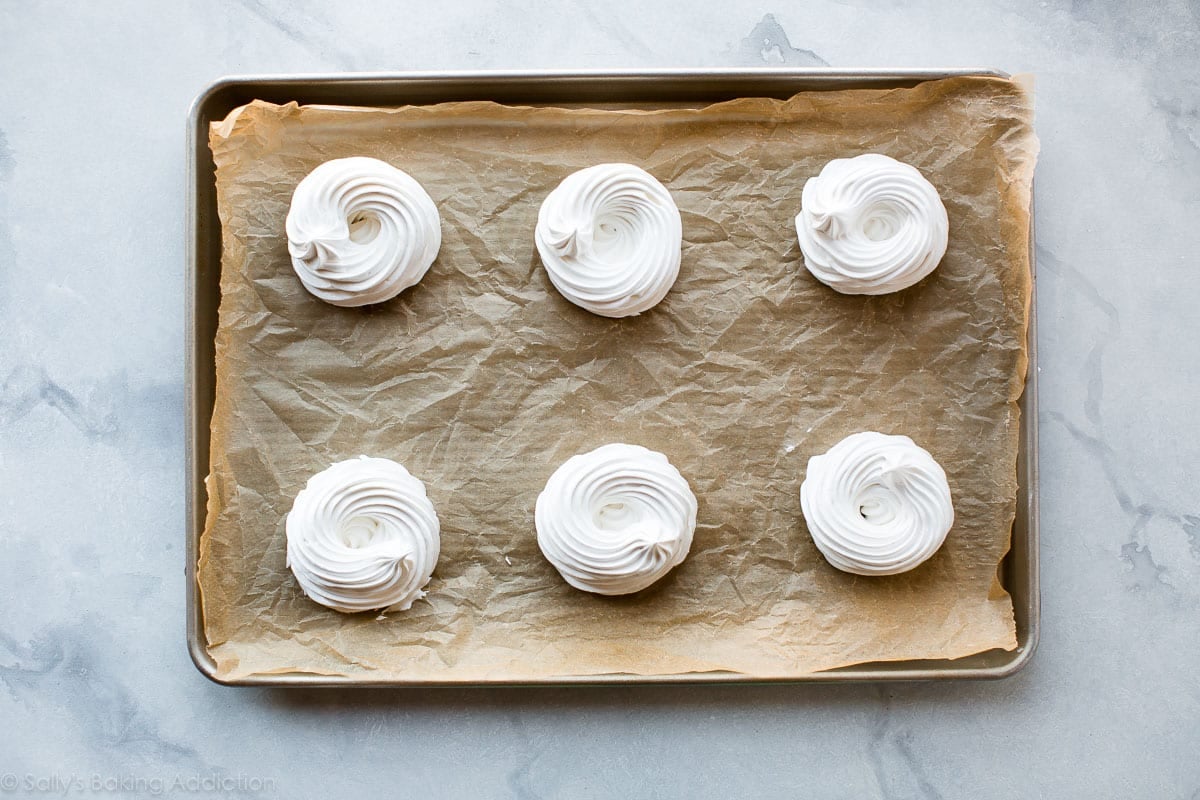
A relatively cooler oven is imperative for properly cooking your pavlova, but let’s start the pavlova at 350°F (177°C) then reduce it down to 200°F (93°C). I do this to help “set” the outer crust quickly. This trick helps reduce spread.
A properly cooked pav is pale in color. Cracks and bumps are par for the course, but the pavlova shouldn’t completely deflate. Especially if you follow the precise measurements and instructions in the recipe. You can help avoid too many cracks by cooling the pavlova in the oven. The sudden change of temperature (inside the oven to outside the oven) shocks the pavlova, so it’s best to cool inside the cooling oven.
Make sense?
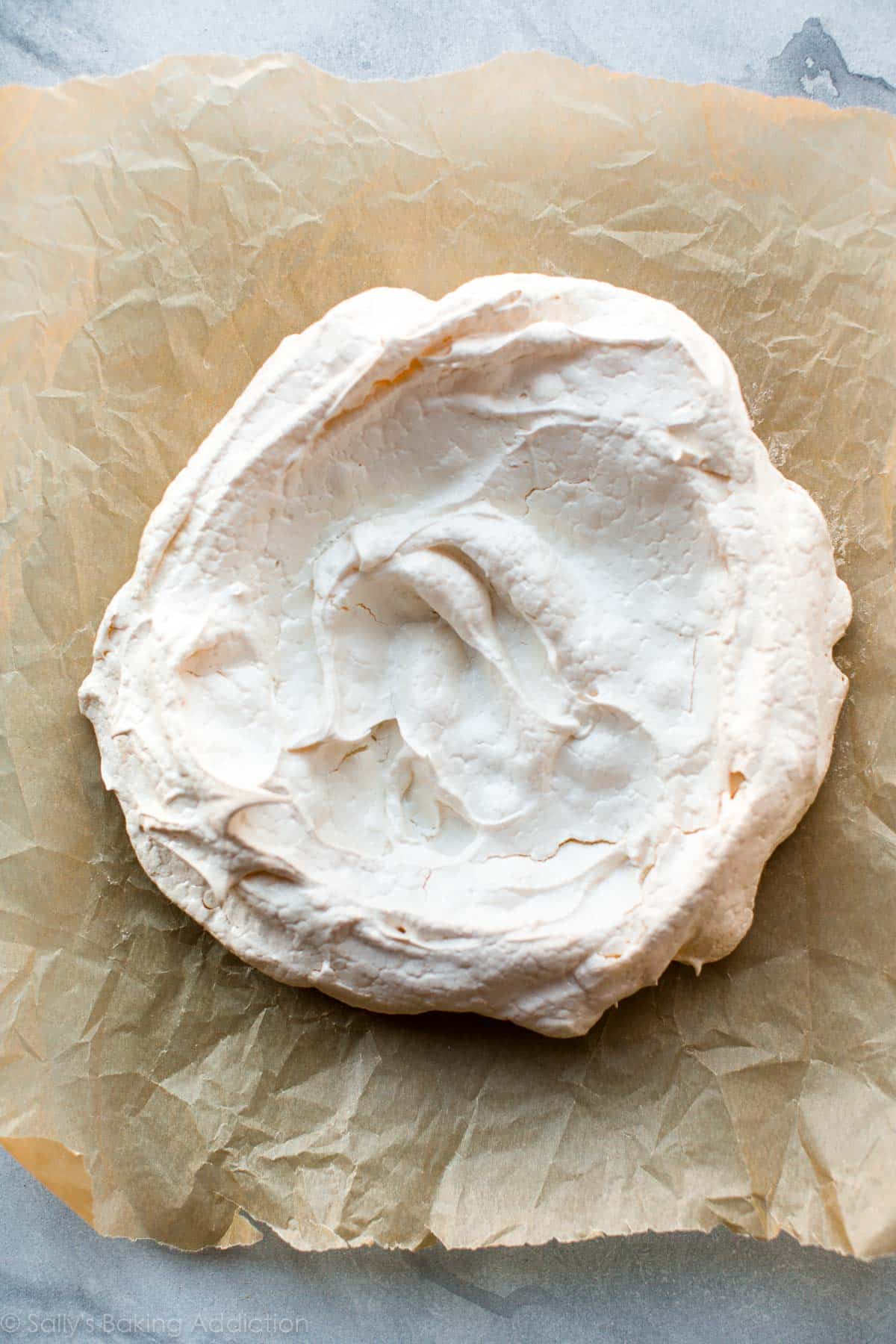
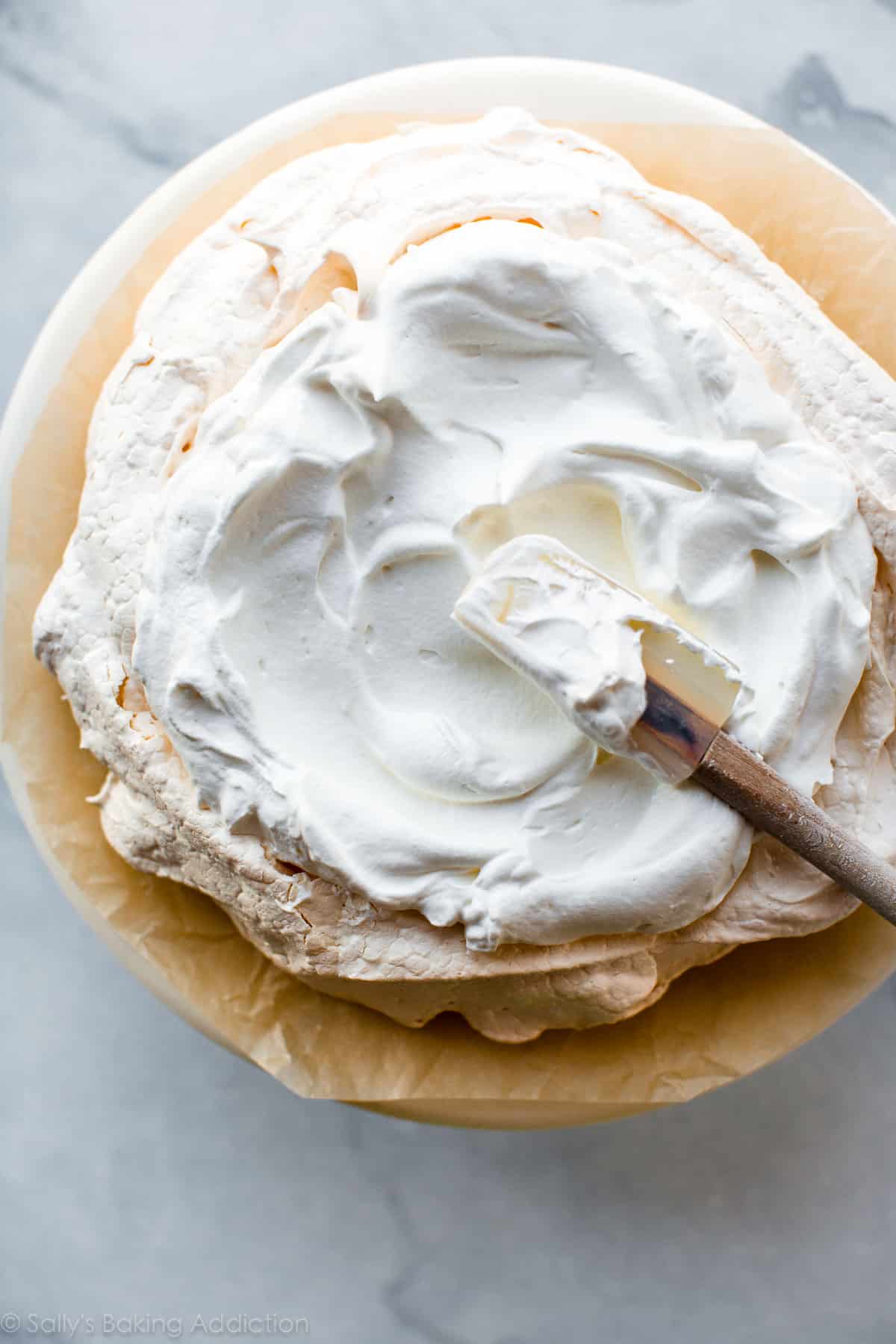
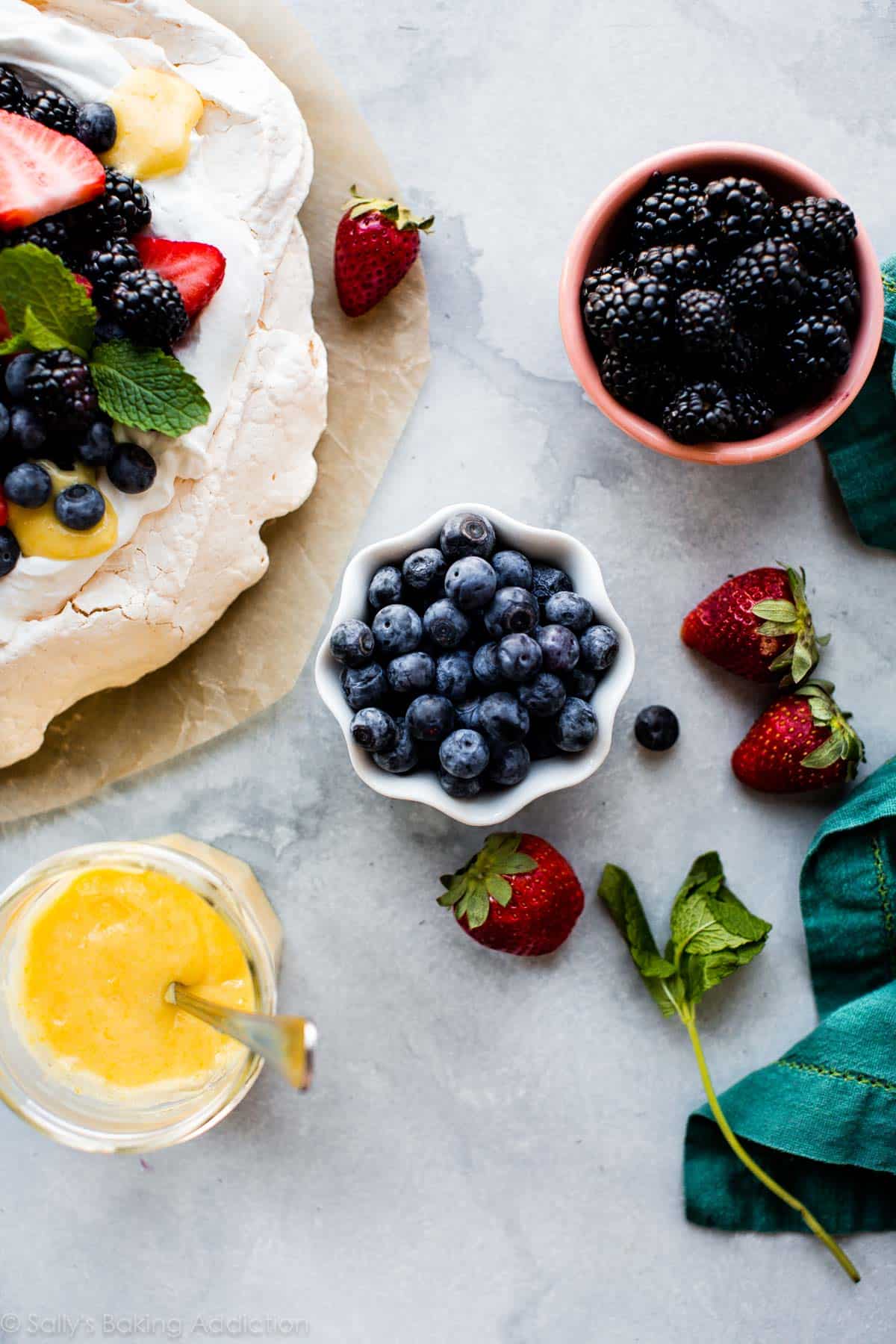
You can top your pavlova or mini pavlovas any which way, but here are some of my topping suggestions:
- Whipped cream is essential. You can get a little creative and flavor your whipped cream. Here are some fun flavored whipped creams.
- Homemade lemon curd. You’ll have exactly 4 egg yolks leftover anyway.
- A lot of fresh berries… enough to make a fruit pizza jealous!
- Edible florals and herbs
- Strawberry sauce, raspberry sauce, or blueberry sauce
- Chocolate shavings
- Seasonal fruits like mango, kiwi, passionfruit, blood oranges
No need to get artistic, just pile it all on top into a massive pavlova mountain.
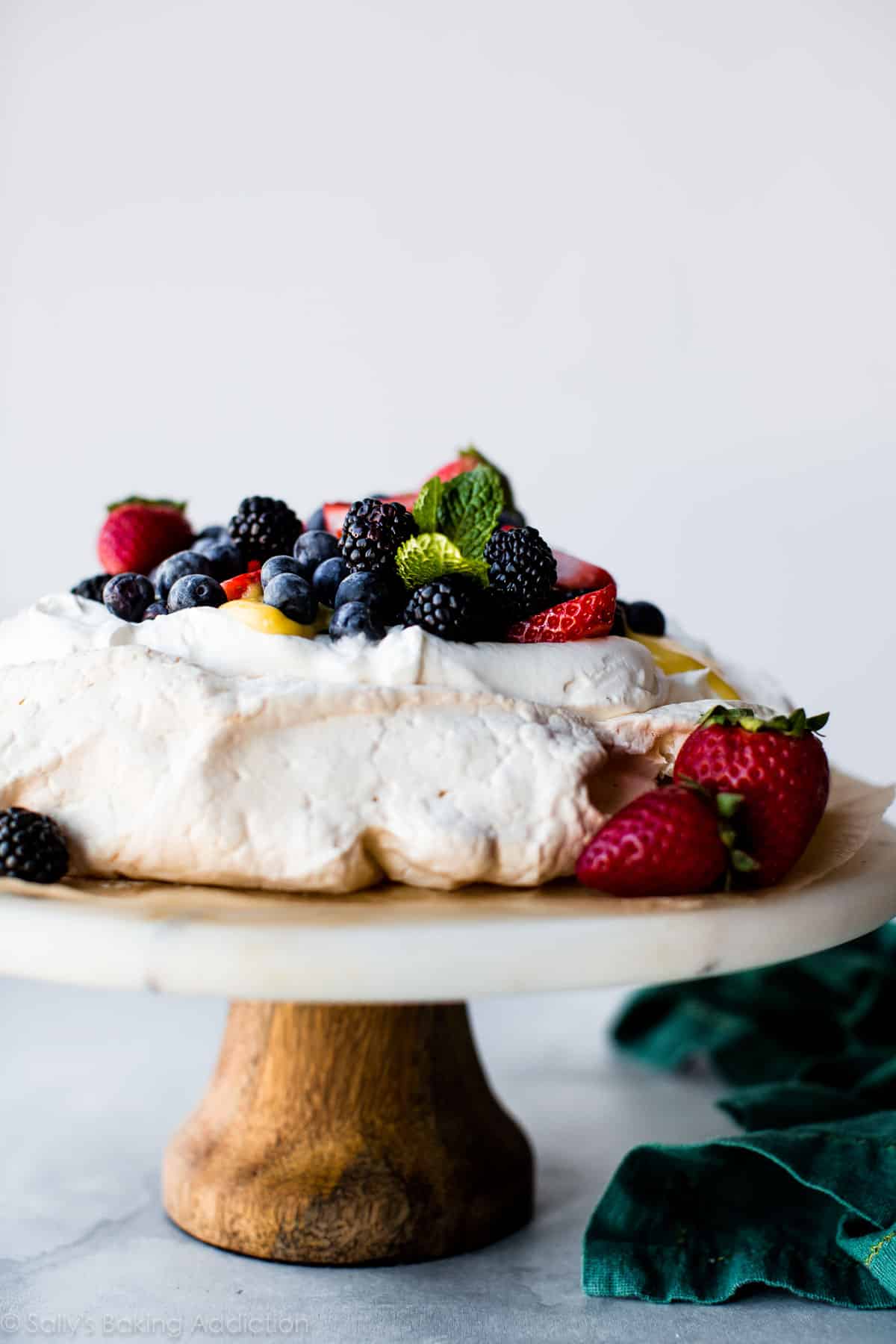
Things are bound to get a little messy when slicing, but if you cooked the pavlova long enough so that the bottom is crisp and the edges are set, it will hold a pie slice shape. This big thing serves about 8-10 people!
If you’re still on the fence about trying pavlova, might I remind you that the center tastes like marshmallows.
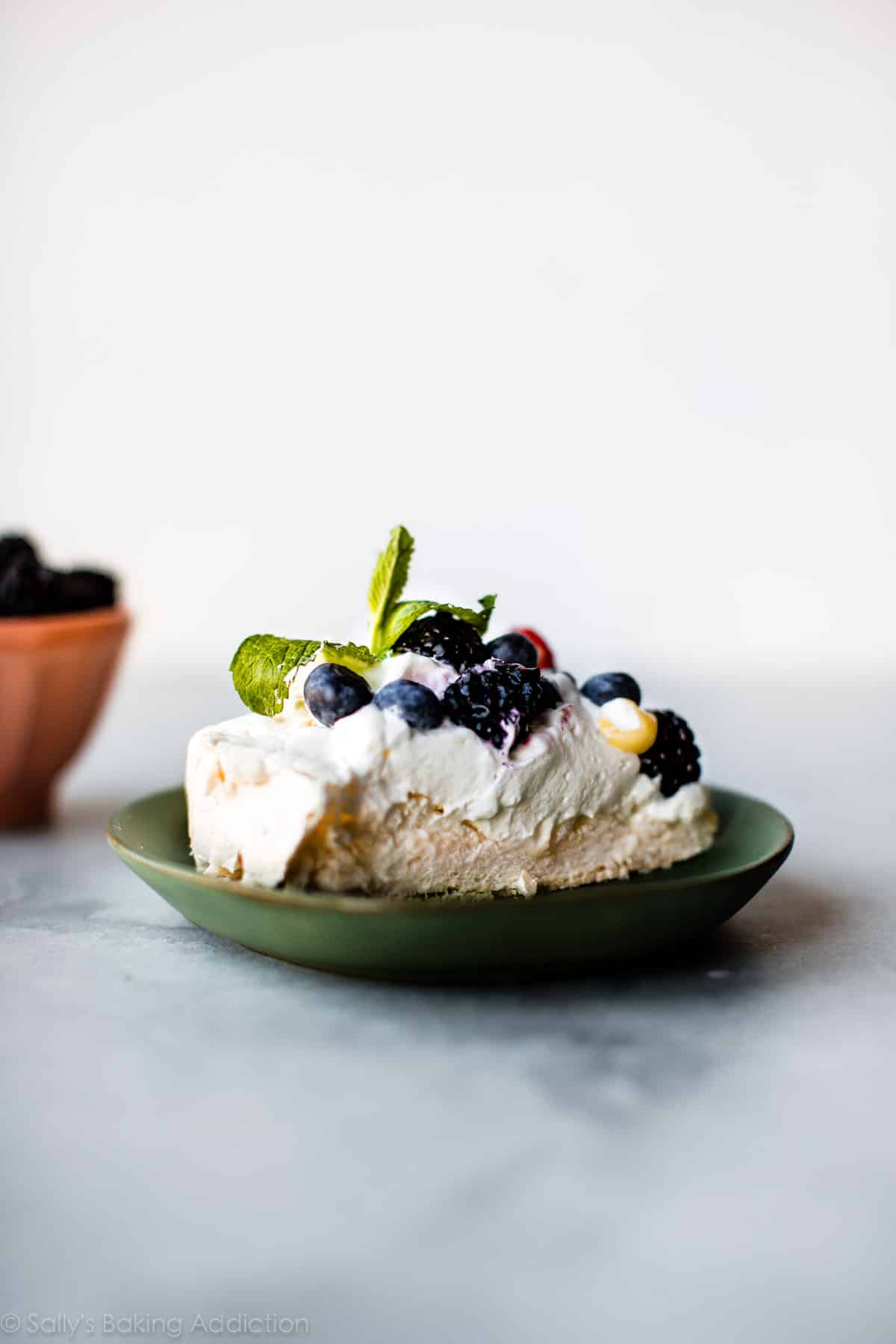
Have fun!
For more gluten-free baking inspiration, here are 40 gluten-free dessert recipes that are always a hit, including cranberry frangipane tart and flourless chocolate cake.
Print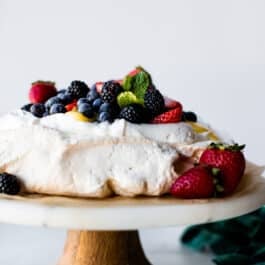
Pavlova
- Prep Time: 20 minutes
- Cook Time: 90 minutes
- Total Time: 4 hours
- Yield: serves 8-10
- Category: Dessert
- Method: Baking
- Cuisine: New Zealand
Description
Pavlova is crisp on the edges, chewy on top, and marshmallow soft and creamy in the centers. Pile high with lemon curd, whipped cream, and fresh fruit to make a naturally delicious gluten free dessert!
Ingredients
- 4 large egg whites (use the yolks for lemon curd!)*
- 1 cup (200g) superfine sugar*
- 1 teaspoon pure vanilla extract
- 1/2 teaspoon cream of tartar*
- 1 teaspoon cornstarch
Toppings
- Homemade whipped cream, fresh fruit, strawberry topping, lemon curd, or any desired topping (see post for suggestions)
Instructions
- Preheat the oven to 350°F (177°C). Line a large baking sheet with parchment paper or a silicone baking mat. (Preliminary note: you will quickly reduce the oven to 200°F (93°C) in step 4.)
- With a handheld mixer or a stand mixer fitted with a whisk attachment, beat the egg whites on medium-high speed until soft peaks form, about 5 minutes. Add the sugar in 2 additions, beating for 30 seconds between. Once all of the sugar has been added, turn the mixer up to high speed and continue beating until glossy stiff peaks form, about 2 minutes. The peaks should be stiff enough that you can hold the whisk upright and the peaks won’t move. Add the vanilla extract and beat for 1 more minute. The peaks should still be very stiff. If not, keep on mixing on high speed. Using a rubber spatula, fold in the cream of tartar and cornstarch.
- Spread the pavlova mixture into an 8-9-inch circle (see note for mini size). You can make decorative peaks with the back of a large spoon if desired. Make sure the edges are relatively tall and there is a nice dip in the center.
- Place pavlova in the oven. As soon as you close the oven door, reduce heat to 200°F (93°C). The pavlova will stay in the oven as it cools down to 200°F (93°C). Bake until the pavlova is firm and dry, about 90 minutes total. Rotate the baking sheet if you notice some spots browning. Try to limit how many times you open the oven as the cool air will interrupt the baking.
- Turn the oven off and let the pavlova cool inside the oven. Once the pavlova is cool, you can store it covered at room temperature for up to 2 days. Or serve right away.
- Once cool, top the pavlova with whipped cream and assorted toppings. Slice and serve.
Notes
- Make Ahead Instructions: See step 5 for making the pavlova in advance. Pavlova is best enjoyed right after it’s garnished. It doesn’t freeze well.
- Special Tools (affiliate links): Electric Mixer (Handheld or Stand) | Baking Sheet | Silicone Baking Mat or Parchment Paper | Marble Cake Stand or Serving Platter
- Egg Whites: (1) Room temperature egg whites whip faster than cold egg whites. And (2) room temperature egg whites whip into a greater volume than cold egg whites. So make sure your egg whites are at room temperature before beginning.
- Sugar: Superfine sugar dissolves easier into egg whites. To avoid tasting sugar granules, pulse 1 cup granulated sugar a few times in a food processor. You now have superfine sugar to use in the recipe.
- Acid: You can use 1/2 teaspoon of cream of tartar or 1 teaspoon of white vinegar, apple cider vinegar, or lemon juice.
- Mini Pavlovas: Divide pavlova mixture up into individual portions instead of spreading into one large 8-9-inch circle. In the photos, I piped the mixture into 6 mini pavlovas using Ateco 849. A piping tip isn’t necessary—you can just spoon it on. Make sure you leave a dip in the center to hold the toppings. Bake time depends on size, see step 4 for what to look for. If making 6 mini pavlovas like I did, bake for 35-40 minutes at 200°F (93°C). Start them in a 350°F (177°C) oven, like I do in this written recipe.
- Pavlova base from reader Laurel. Thanks, Laurel!



















Can you use a 1:1 sugar substitute like Besti and still achieve the texture?
Hi Kelly, We’d love to help but we are not trained in baking with sugar substitutes. For best taste and texture (and so you don’t waste your time trying to adapt this recipe since it may not work properly), it may be more useful to find a pavlova recipe that is specifically formulated for sugar substitutes. Thank you!
We made this today (because of the Bluey episode) and I made it with the attached lemon curd. The two together were incredible. The overly sweet pavlova was perfectly balanced by the lemon curd and the fresh fruit was a nice add on top. This will be made again soon for sure!
Hi Sally! If I’m using white vinegar, when should I add it?
Hi Andreea, you can add it at the end of step 2, when you would alternatively add the cream of tartar.
Hi Sally ! May i know instead of white castor sugar can i use soft brown sugar ? And also if i dont have apple cider vinegar , can i use white vinegar ?
Hi Nur, we haven’t tested the recipe with those ingredients, so are unsure how it would turn out.
I wanted to make a pavlova in honour of the memory of a dear friend of mine who was from New Zealand. Sally’s recipes never fail me, and this one was no different! I was a bit nervous as I’ve never made something this delicate, and my scale is broken so I had to go by other measurements instead of weights, but it turned out great. I made 6 minis and the texture of the pavlova is perfect, crisp and delicate and so fluffy inside. I’ll definitely be using this recipe again next time I need to make a dessert to impress someone.
Can I double this recipe
Hi Kit! For best taste and texture (and best success!), we highly recommend making two batters/two batches instead of doubling all at once.
Thank you for a successful recipe! My Bluey-loving kids were delighted. Reduced the entire recipe by 1/4 but a bit too sweet for our house. Cook time was still about 70-80 min.
Purely informational– I found an old Melissa d’Arabian article that says you can usually cut sugar amount by half with minimal effect on classic pavlova texture. She tested as low as 2 tsp per egg white but ended up with a much drier, crisper texture. For anyone wishing to experiment!
Perfect technique. Increased by 1/2, but did not need to increase baking because I just made the pavlova wider (not taller). Loved how the sides were moist and mashmallowy!
Filled my mini pavlovas with a “lemon mousse” made from Sally’s lemon curd recipe folded into 1.5 cups cold heavy cream (whip cream stiff, loosen curd by stirring in a bit of lemon juice if needed, then fold gently together). Topped with blackberries… very good!
Hi Sally! I hope you’re well.
Can I make this pav into a roll? If so how long do you think I would need to bake it for, assuming it will be a thin sheet for me to then roll with fruit cream and lemon curd inside?
Hi Monica, I haven’t tested this particular pavlova recipe as a rolled loaf, so I’m not sure. Let me know if you do!
Gotta love Bluey for inspiring so many families to try this recipe together I am about to make this with my 6yo and 2.5yo, while our Bluey character figurines watch. Thanks for the recipe and the breakdown of WHY the ingredients are used. It really helps me when I go to adapt other recipes down the line. Appreciate it.
We made the regular sized pavlova and I’m not sure we let it cool long enough, it was kinda wet and almost runny still in the center despite following the directions. The flavor was good though. I’m attempting the mini pavlovas now and actually made 7 mini pavlovas and they got out in the oven for 40 minutes, which is the higher end of the time for 6 according to the recipe but parts of the “shell” are still soft and definitely not hard. Mainly the center part where toppings would go. I’m not sure how long they need to cook now as clearly the cooking time shown here isn’t correct, hopefully another 15-20 minutes is enough, though I’m unsure what he opens if you accidentally over cook it.
So easy and so good. Everyone loved it
I’m not the only parent in my family love to cook pavlova. That’s why we enjoy doing together.
More Bluey fans here! Because of the show, which is hysterical and I encourage adults to give it a try, our pavlova is in the oven now. My 6 y.o. Has been talking about pavlova for weeks after watching the Bluey episode that features the dessert, is very excited to try it!
Hi, I tried this recipe but my egg whites got runny soon after I added the sugar. This happened twice. Any reason why
Hi Sim, they may thin out at first but keep whipping and they will eventually hold enough air to form peaks.
This happened to me, too. I whipped and whipped. Twenty minutes elapsed and they were still runny. I wish I hadn’t wasted so much time thinking they’d “eventually hold enough air to form peaks”.
I know when I make meringues here in Maryland, it’s too humid in summer for them to set right – I can only make them in winter. Any idea if a pavlova would be similarly affected?
It’s a little too humid for it to turn out properly. At least from my experience. I have better luck in fall, winter, and spring.
My grandkids watch an Australian kids show called Bluey. One episode features Pavlova which is quite funny as Bluey and family are dogs. The kids are really excited to try the recipe. Especially after I repeatedly assured them it was a real food and quite sweet,
How sweet 🙂 Hope they love the Pavlova, Alesa!
I’m not the only parent! Bluey inspired my kids and I. To attempt to make this delicious Australian treat! We Love it!
-thanks for the recipe!
Ha. We also came looking for a pavlova recipe because of Bluey. My 3 year old loved helping to make it (and then devour as much as I would let him). After glancing at a few other recipes, I did add a pinch of salt, but otherwise followed the recipe and it was delicious!
Bluey inspired me also to make this pavlova recipe for the first time! The recipe turned out perfect. I also made the lemon curd and whipped cream recipes she linked in the pavlova recipe. So delicious!!
We also found this via Bluey! My 4 yr old still pronounces it “pavlovar” because of the Heeler’s Australian accent. Haha.
Came out wonderful!
I love pavlova! Used your recipe and was delicious. Going to make again and have a couple questions. 1. My last one cracked when I was adding whipped cream on top. Any tips to make sure it holds together? 2. If I make 2 batches (individual of course) can I bake two cakes at same time? Or best to bake one after the other? Trying to save some time here!!
Hi Natalie! So the pavlova is quite fragile and I’m not sure how to prevent it from cracking unless you just be very light and careful when you’re adding a topping. You can bake two at once, the bake time will pretty much be the same or a few minutes longer.
Is it possible to half this recipe? I’m bringing dessert to a dinner but there’s only 4 of us.
Hi Michelle, You can halve the recipe. We’re unsure of the exact bake time. It’s done when it feels firm and dry.
Great recipe! Topped with whipped cream, strawberries and peaches. I’m in Denver and didn’t seem to need any altitude adjustments.
Can I double this recipe for a larger group?
Hi Hailey, For best taste and texture (and best success!), we highly recommend making two batters/two batches instead of doubling all at once.
Hi! I made individual pavlovas and I wanted to ask you about the final texture once they are baked, as they looked a little bit rough, not completed smooth on the outer layer, but with those little “waves” just like the one you did. I cooked them at 100 celcius, for 1 hour, with a convection oven (bottom heat and fan on). I wanted to ask you if you know why this happens, is it because of the fan? Or something to do with the meringue process? The inside texture is great but I would like it to be really smooth on the outside. Thanks a lot!!! Saludos desde Argentina!
Hi Vane! A free form meringue won’t be perfectly smooth – the texture gives it great crunch!
Made grapefruit curd using this recipe. Absolutely delightful
I’m making this today. Another recipe also added lemon curd. I’m going to add this. It might also help with the sweetness.
Hi Wendy, we love topping pavlova with homemade lemon curd! Let us know how it goes for you.
Made this last night and it was excellent! Followed the recipe exactly, though I had to leave it in a bit longer when I realized halfway through baking that my oven was running a bit cool when I set it to 200. Even with that temperature snag, the end result was perfect in texture and structure.
I did find it to be a little too sweet for my taste — I wonder if reducing the sugar by half in the recipe would cause any issues with the final result? Any feedback or experience from anyone reducing the amount of sugar?
Hi Teresa! We’re so glad you enjoyed the pavlova. Without the full amount of sugar the egg whites would deflate and you wouldn’t get the crisp exterior. Maybe try a topping that isn’t as sweet for him to help offset the sweetness in the pavlova.
I can’t wait to try this! I have an abundance of duck eggs and often use them in my baking. Do you think using them will make a difference?
Can’t wait to make this pavlova!
Is it possible to use powdered sugar instead of superfine/caster sugar? If so, should I use the same quantity? Thank you!
Hi Michael! Powdered sugar is too fine and fluffy for the recipe. Superfine is best!
You say to start the pavlova at 350 then quickly reduce to prevent spreading. How long does it stay at 350? There’s no instruction for this.
Hi Amy! See step 4 – As soon as you close the oven door, reduce heat to 200°F (93°C). You leave the pavlova in the oven as the oven changes temperature.
Does altitude affect any part of this recipe ?
6400 ft
Hi Renee, we wish we could help, but we have no experience baking at high altitude. Some readers have found this chart helpful: https://www.kingarthurflour.com/learn/high-altitude-baking.html
Just made the mini version. First time I’ve made pavlovas, so I was a little nervous but they came out AMAZING! Followed the directions exactly. (I can’t find superfine sugar around here, so I ran regular sugar through the food processor.) Light and crispy on the outside, soft and marshmallowy on the inside. A perfect bed for fresh wild black raspberries. Will definitely make again.